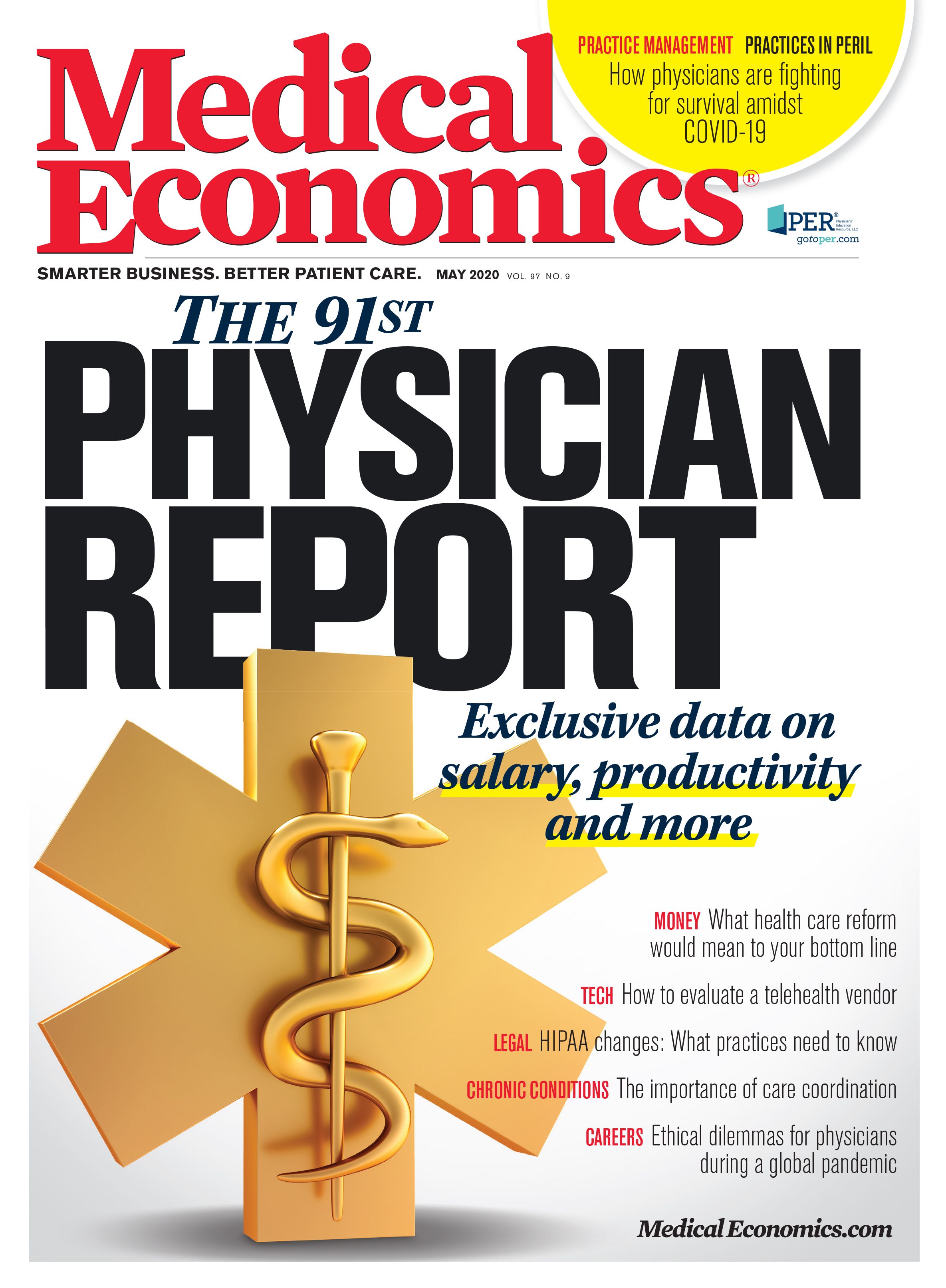Publication
Article
Medical Economics Journal
Medical practices reel financially from COVID-19 losses
Author(s):
What will happen long term is unclear, but doctors and observers say the actions taken so far by the government to support practices are inadequate and that more needs done.

America’s physician practices face devastating financial losses due to the COVID-19 pandemic. What will happen long term is unclear, but doctors and observers say the actions taken so far by the government to support practices are inadequate and that more needs done.
Currently, physician practices are experiencing 30% to 75% decreases in patient volume, says Halee Fischer-Wright, M.D., president and CEO of the Medical Group Management Association (MGMA) headquartered in Englewood, Colorado. The business of primary care practices is down 40% to 50%, she says.
The situation would be even more dire if not for telehealth and the new willingness of the Centers for Medicare & Medicaid Services (CMS) to cover virtual visits. “Since CMS changed their regulation of reimbursement, we’ve seen telehealth enthusiastically embraced across the country, to the point where it has become an integral part of care delivery just in the [past] three weeks,” Fischer-Wright says.
Nevertheless, many small, independent practices are having difficulty ramping up telehealth systems and workflows. Even if they can master this technology quickly, most small practices have no more than two or three months of operating expenses in reserve, notes Medhavi Jogi, M.D., co-owner of Houston Thyroid & Endocrine Specialists, a five-physician group practice. At some point, unless the crisis ebbs fairly soon, many independent practices will have to consider reducing physician compensation and/or laying off staff to survive.
Some practices may not survive. “Without immediate governmental action, practices around the country will fail,” wrote Jeff Livingston, M.D., CEO of MacArthur Medical Center in Irving, Texas, in a recent opinion piece. “The U.S. will be faced with an unprecedented crisis of unemployed physicians right at the potential peak of the COVID-19 pandemic.”
System-owned vs. independent practices
Physicians employed by health care systems are in better financial shape than independent doctors, at least for now. For example, internist Jeffrey Kagan, M.D., recently joined Hartford HealthCare, a large system based in Hartford, Connecticut, after many years as an independent practitioner. Kagan became part of Hartford on Feb. 3, just weeks after the first confirmed U.S. case of the COVID-19 virus.
Kagan is grateful he made the move when he did. “It couldn’t have happened at a better time,” he says. “With the decreased volume of patients we’re taking care of, I’m [still] able to get my salary. Otherwise, I don’t know whether I could keep my staff and overhead going.”
Another advantage: The system immediately got Kagan up on its telehealth platform, enabling him to conduct virtual visits with many of his patients. He says he doesn’t know whether he could have made the transition to telehealth as well on his own.
Kagan is still seeing patients with urgent nonrespiratory issues in person but is taking care of other patients via the telehealth app in the patient portal of Hartford’s electronic health records. Still, his appointment volume is down 50% to 60%. On a typical day recently, he saw three people in the office and eight via telehealth.
Pay cuts and layoffs
Yul Ejnes, M.D., is an internist with Coastal Medical, the largest primary care group practice in Rhode Island. Unlike Kagan, he can’t count on a fixed salary. As one of the physician owners in the 125-provider Providence-based practice - which bases compensation on productivity - Ejnes realizes the reduced volume he’s experiencing will eventually require him to take a pay cut.
Ejnes is still working in his office but is doing mostly virtual visits. “We’ve converted our regular day schedules to telehealth - either audio-video or telephone,” he says. “Our organization has been able to set up a couple urgent care clinics for people who really need to be seen. We’ve
segregated that into respiratory sick visits and nonrespiratory sick visits. We haven’t been able to reach some patients to tell them their office visits are being turned into telehealth visits, and they’ve come in. I saw one [in-person] patient this week, and [everyone] else has been [seen] remotely.”
Ejnes says he is now seeing two-thirds as many patients as he saw before. Of the 12 virtual visits he conducted recently, five were audio-video and seven were via phone. For people with respiratory complaints, he manages them virtually if they’re not too ill. If they’re too sick to manage virtually but not ill enough to send to the emergency department, he refers them to the group’s respiratory urgent care clinic.
The group hopes to avoid layoffs, but private practices generally aren’t bringing in enough revenue to make payroll, Ejnes says. Some of his office’s medical assistants are working from home because patients are not coming into the office. Even with virtual visits, administrative tasks such as managing lab results and handling correspondence and forms have decreased significantly.
“There are other needs that are new, such as transitioning people from in-person visits to telehealth visits and teaching or guiding them [to install the apps],” Ejnes says. “But the overall result is that there might be a decreased need for support staff. And the possibility of furloughs is definitely an option.”
Small practices face threats
Jogi, the Houston endocrinologist, says his practice switched completely to telehealth in late March and sent all of its staff home. But it’s still unclear how long the practice will be able to survive in its current form, Jogi says.
Unlike many small practices, which have been reluctant to embrace telehealth, Jogi and his colleagues have been conducting virtual visits for the last five years. About 30% of Jogi’s visits were virtual even before the pandemic. Although virtual visits comprised a much smaller percentage of the other doctors’ visits before, “they all knew how to do it, and the systems were in place,” he says.
The practice has halted in-office procedures, such as thyroid biopsies and thyroid ultrasounds, because Texas banned all procedures at least through April - another financial hit for the practice. In addition, Jogi notes, many patients with diabetes and other metabolic disorders are afraid to go to Quest Diagnostics or LabCorp for testing. That has reduced patient volume because there’s not much to talk about with these patients in the absence of recent lab results.
The cash flow in Jogi’s practice has not dropped off yet because payments from claims filed weeks ago are still coming in. But he and his two partners (the other doctors are employees) are keeping a close eye on their bank statements. “Once we start seeing the daily [electronic] check deposits drop, we know we’re going to have to change some staffing,” he says.
As long as the group can keep telehealth volume up, he adds, he doesn’t think they’ll have to let the employed doctors go. “But it will probably tank at some [point], and we’ll have to ask for concessions. If they’re not willing to concede, there may be layoffs.”
Long-term outlook
Observers expect that most independent practice leaders will delay layoffs for now. “The sequence is often that practice owners take home less money,” says Joshua Halverson, who holds a master’s in both public health and health administration and is a principal at ECG Management Consultants. “I’m not hearing people talk about big layoffs of clinical staff. There are a lot of people still hopeful that this is a temporary - month or two - situation and [that] people can hold off. ...”
Fischer-Wright of MGMA says that layoffs carry costs, which can include an increase in an organization’s unemployment insurance tax rate. “More often than not, it’s better to keep people furloughed [than to lay them off],” she says. “It’s probably better in the long run, if you have good staff, to furlough the staff.
“At the same time, I’m seeing practices that are using this crisis as an opportunity to separate staff that are less than optimal.”
Planning how to deal with staff and other overhead costs depends on how long the crisis lasts and how severe it is in a practice’s geographic region, Fischer-Wright says. MGMA forecasts that the crisis will continue for at least another three to four months and possibly longer.
“Practices should be reasonable about expectations for their volume and how long this downturn is going to last,” she says. “If you’re a primary care practice, this is probably a six- to eight-week period in which you can count on volumes being down 50% to 60%. Then you can figure another four to six weeks while that volume builds up, when your volume is down 20% to 30%. Then you’re going to have to expect your volume to be only 80% to 90% of what it was for the rest of the year. It’s not going to be 100% because there will be high-risk populations who shouldn’t be in the office environment until we have an effective vaccine and treatment available.”






